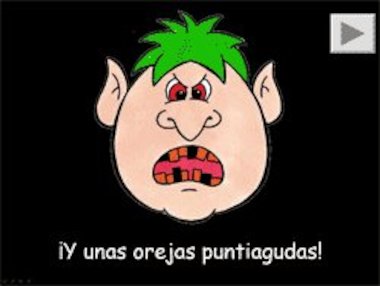If I had to choose a favourite topic from my long list, this would be my first choice, it is fun and challenging! Depending on the year and the length of the lesson, I combine this topic with descriptions.
Mr. Potato Head(s) for vocabulary practice
I have quite a few in my house, I wanted to take a picture of three but my daughter ran away with one....We play the hot/cold hiding game with the individual body parts, it is a good way to practise "j" in "las orejas" y "los ojos". If I take all the bits off the heads, then we can do a "Who is quicker?" competition in front of the class, the two volunteers have to find the body parts from the pile and put them in the right place.
The display
This skeleton comes from the Halloween sales.It looks great on the display with the Spanish vocabulary on. We learn body parts in Year 4 and the pupils are getting familiar with genders and plurals by then, that is why my labels are colour coded. So far we have played the "Who is quicker?" game with the skeleton (show the body parts), but I have just read a very good game and I will recycle it. There will be two doctors (yes, I have the outfits:-) competing to cure the poorly skeleton. They will get small plasters and the voice of the skeleton (teacher/pupil)will say: "Me duele la boca." or "Me duele la nariz", etc. The doctors will have to race to the patient and put a plaster on the sick body part. This idea was inspired by Susan Thomas on the Facebook page "Fun for Elementary and Early Spanish Teachers".
Tiene....
To introduce describing somebody with "Tiene...", I use my teddy monster, or a pupil with the monster hat on:-) After talking about the differences in "Tiene..." and "He/She has got", we practise the verb with María:-).
"Tiene" practice with María
She is called María, she is a puppet head from Cuba, I got her in a carboot sale. I blindfold a volunteer and give María to somebody in the classroom who has to shake her (she is full of rice). The blindfolded pupil has to guess who has her and says: "La tiene Amy", "La tiene Connor", etc. You can play it with a rattle or anything noisy.
Monster beauty contest
Now it is the children's turn... they have to design a monster or an alien! I give them big sheets of paper and they can work in groups of 2 or 3. This activity is about 15 minutes long during 3 weeks (I have 1 lesson a week with my classes).They have to design a monster or an alien, label them and colour them in. Then the pupils come out to the front of the class and talk about their monsters: "Tiene 3 orejas", "Tiene ocho ojos", "No tiene boca", etc.... They get a number from me, and at the end of the activity we vote for the best one. The winner's piece of art will be displayed on the wall. But of course we are all winners because we all talk in Spanish in front of our class and we are very proud of our work. I take a photo of the monsters, label them in PowerPoint (to be clear and easy to read) and laminate them. They can take them home for placemats, and I keep the originals on my living room wall ( well, this is what I tell them:-). Laminating pouches are very cheap in Home Bargains, I prefer laminating at home as I have a very quick hand held laminator.
Those who finish earlier than the others can practise writing sentences about playdough monsters:-).
The blindfolded artist
Pair work on small whiteboards, or 2 pupils can come out to the big whiteboard and we all have a laugh. The blindfolded artist follows the instructions of the partner who says sentences like: "Tiene una boca", "Tiene 3 ojos", "Tiene 5 orejas". When the picture is finished, the blindfolded pupil can have a look at his/her masterpiece. It is a hilarious activity! Sometimes we play it as a "beauty contest" between the boys and the girls in the class and the class teacher has to decide whose monster is more beautiful, which is quite challenging as they haven't got any body parts in the right place!
Chuchua
Just follow the instructions, it is hilarious. The actions are tiring, so be prepared! The lyrics are here. ( The video is a bit different, it says "hombros en alto" and "culete atrás".)
Con mi dedito
A lot quieter than Chuchua:-) You can add more body parts to the song. I used it in KS1 many times before, they loved it.The lyrics are here.
To be continued.... this topic is a treasure box!
























